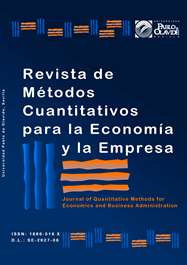Combination of the CART method and cross-section econometrics for the identification of determinants: Survival of Argentine exports
DOI:
https://doi.org/10.46661/revmetodoscuanteconempresa.3307Keywords:
trade flows, exports, survival, CART, cross section econometricsAbstract
This paper identifies factors that explain the survival of Argentine trade flows using the combination of the Classification And Regression Tree analysis (CART) method and cross-section econometrics as the identification method. While the first determines the best predictors, the second offers a global function that links the dependent variable with those. The combination of these methods allows to reduce the number of potentially explanatory variables in problems in which there is no theoretical consensus, or to resolve situations in which there are non-linear relationships, missing data or anomalous observations. The application to the case study allows us to observe that there is a significant difference between pre-existing export flows and new flows, even though the explanatory variables of their duration turn out to be the same.
Downloads
References
Besedes, T., & Blyde G. (2010). What drives export survival? An analysis of export duration in Latin America. Institute of Technology, Inter-American Development Bank.
Besedes, T., & Prusa T. (2006a). Ins, outs, and the duration of trade. Canadian Journal of Economics, 39, 266-295.
Besedes, T., & Prusa T. (2006b). Product differentiation and duration of US import trade. Journal of International Economics, 70, 339-358.
Besedes, T., & Prusa, T. (2007). The Role of Extensive and Intensive Margins and Export Growth. Working Paper 13628, NBER.
Blanco, A., Irimia, A., & Vázquez, M. (2016). Diseño de un modelo específico para la predicción de la quiebra de micro-entities. Revista de Métodos Cuantitativos para la Economía y la Empresa, 22, 3-18.
Brenton, P., Saborowski, Ch., & von Uexkull, E. (2009). What Explains the Low Survival Rate of Developing Country Export Flows? The World Bank Poverty Reduction and Economic Management Network International Trade Department, June.
Corbella, V. (2016). Asimetrías Estructurales, Integración Comercial y Especialización Industrial: el caso de la UNASUR. Tesis de Magíster en Economía. Universidad Nacional del Sur.
Fugazza, M., & Molina, A.C. (2011). On the determinants of exports survival. Policy Issues in International Trade and Commodities Study Series, 46. Geneva: United Nations.
Gepp, A., & Kumar, K. (2015). Predicting financial distress: A comparison of survival analysis and decision tree techniques. Procedia Computer Science, 54, 396-404.
Giordano, P. (2016). Cambio de Marcha. América Latina y el Caribe en la nueva normalidad del comercio global. Monitor de Comercio e Integración, BID, Washington DC. https://publications.iadb.org/handle/11319/7942
González, B. (2015). Supervivencia de los Flujos de Exportación. Análisis de la Duración a Nivel de Producto-Destino para Argentina 1993-2012. Tesis de Maestría en Economía, Facultad de Ciencias Económicas Universidad Nacional de La Plata.
González-Fernández, M., & González-Velasco, C. (2016). Which Countries Pay More or Less for Their Long Term Debt? A CART Approach. Journal of Quantitative Methods for Economics and Business Administration, 21, 103-116.
Lall, S. (2000). The Technological Structure and Performance of Developing Country Manufactured Exports, 1985-1998. Working Paper 44. Queen Elizabeth House, Oxford University.
Nicita, A., Shirotori, M., & Tumurchudur, B. (2013). Survival Analysis of the exports of least developed countries: the role of comparative advantage. Policy Issues in International Trade and Commodities Study Series, 54. Geneva: United Nations.
Nitsch, V. (2007). Die another day: duration in German Import trade. CESifo Working paper 2085. Munich: CESifo.
Rauch, J. (1996). Networks versus markets in International Trade. Working Paper 5617, National Buerau of Economic Research, June.
Rauch, J.E. (1999). Networks versus markets in international trade. Journal of International Economics, 48, 7-35.
Rauch, J. (2007). Development through synergistic reform. National Bureau of Economic Research, June.
Sohn, S., & Moon, T. (2004). Decision tree based on data envelopment analysis for effective technology commercialization. Expert Systems with Applications, 26(2), 279-284.
Tso, G., & Yau, K. (2007). Predicting electricity energy consumption: A comparison of regression analysis, decision tree and neural networks. Energy, 32(9), 1761-1768.
Downloads
Published
How to Cite
Issue
Section
License
Copyright (c) 2019 Journal of Quantitative Methods for Economics and Business Administration

This work is licensed under a Creative Commons Attribution-ShareAlike 4.0 International License.
Submission of manuscripts implies that the work described has not been published before (except in the form of an abstract or as part of thesis), that it is not under consideration for publication elsewhere and that, in case of acceptance, the authors agree to automatic transfer of the copyright to the Journal for its publication and dissemination. Authors retain the authors' right to use and share the article according to a personal or instutional use or scholarly sharing purposes; in addition, they retain patent, trademark and other intellectual property rights (including research data).
All the articles are published in the Journal under the Creative Commons license CC-BY-SA (Attribution-ShareAlike). It is allowed a commercial use of the work (always including the author attribution) and other derivative works, which must be released under the same license as the original work.
Up to Volume 21, this Journal has been licensing the articles under the Creative Commons license CC-BY-SA 3.0 ES. Starting from Volume 22, the Creative Commons license CC-BY-SA 4.0 is used.










